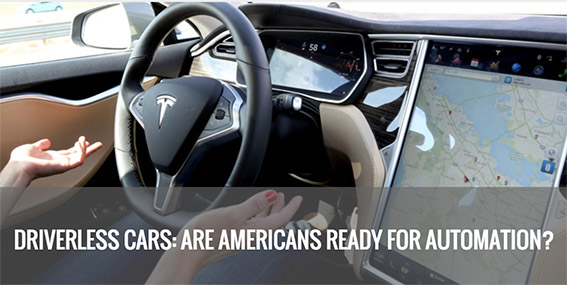
The past few years have been a whirlwind for the autonomous automotive industry. To date, Google’s self-driving cars have driven over 2 million miles and Tesla’s 90,000 cars are equipped with AutoPilot enabling the vehicles to maintain speed, change lanes and even park without any input from the driver. What Tesla advertised as simply a driver’s assistant, is being used as much more than that.
As an article on Wired.com explains, “The Internet is awash in videos of people sitting in the backseat and sleeping, and ignoring Tesla’s TOS requirement that they maintain control at all times.” Videos such as these have prompted backlash, suggesting Tesla may be moving too fast. Elon Musk, Tesla and SpaceX CEO, disagrees. Instead of slowing down, Musk continues to move forward with Tesla’s autonomous endeavors, promising that “he’ll produce a Tesla that can drive itself from Los Angeles to New York City, no human needed.”Technology that seemed fit only for movies such as I, Robot a few years ago, is closer than many people realize. [bctt tweet=”Technology that seemed fit only for movies such as I, Robot a few years ago, is closer than many people realize.” username=”qpaudience”] Begging the question, are Americans ready for this level of automation?
It’s not only tech companies such as Google and Tesla leading the way. Uber is now knee deep in the mix and making a name for itself in the driverless car industry. As of August 2016, Uber deployed a fleet of autonomous vehicles driving the streets of Pittsburg. Bloomberg reports that “Unlike Google and Tesla, Uber has no intention of manufacturing its own cars, Kalanick says. Instead, the company will strike deals with auto manufacturers, starting with Volvo Cars, and will develop kits for other models.” For the time being the cars are being supervised by humans, but expect to be completely autonomous in the future. However, Uber’s initiatives might be premature.
On December 14th, Uber’s fleet of self-driving cars began shuttling passengers around the streets of San Francisco. Within a week of the launch, there were already several safety concerns. One of the vehicles apparently ran a red light and caused a near-collision. Uber claims that this incident was caused by human-error, meaning the driver behind the wheel, though witnesses dispute this fact. Additionally, these autonomous vehicles raise alarm regarding their inability to make right-hand turns without crossing into bike lanes, potentially leading to fatalities. The state of California has threatened legal action unless Uber removes its self-driving cars from the roads until the problems are addressed and the proper permits are acquired. According to an article published by The Guardian, even though Uber openly admitted to the vehicles having a problem with crossing bike lanes, they will not be pulling their cars from the roads. A statement released by Uber VP of Engineering, Anthony Levandowski, explains, “…we respectfully disagree with the California Department of Motor Vehicles legal interpretation of today’s autonomous regulations, in particular that Uber needs a testing permit to operate its self-driving cars in San Francisco.” He claims that because all their self-driving cars are still equipped with a driver and “are not capable of driving ‘without…active physical control or monitoring’” that they do not require a permit. Uber has instead informed all drivers that “they should take manual control when turning right on a street with a bike lane while engineers try to fix the vehicles’ programming.”
Uber’s current safety issues are only one of many obstacles associated with the future of driverless cars. The security risks accompanying autonomous vehicles are vast. Forbes reported that “Last year, security experts proved in a controlled test that they could use the Internet to take control of a car as it was driven down the road. Fiat Chrysler Automobiles consequently recalled 1.4 million vehicles to fix the software defect enabling hackers to control multiple vehicle functions.” It is one thing to have your computer hacked, it is another thing entirely to abruptly lose control of your 4 ton vehicle, moving at 70 mph down the highway. The U.S. Department of Transportation’s National Highway Traffic Safety Administration (NHTSA) is continuously working to improve cyber security to protect against such breaches, but it is an ever-changing environment that requires constant innovation to stay ahead of potential threats.
Even with the security and safety threats constantly being assessed and addressed, many Americans still aren’t convinced. According to the J.D. Power U.S. Automotive Emerging Technologies Study, only 1 out of every 5 consumers was interested in a fully autonomous vehicle.[bctt tweet=” Only 1 out of every 5 consumers was interested in a fully autonomous vehicle.” username=”qpaudience”] However, as history has shown, the advent of new technology is often met with uncertainty. The fact remains that many people enjoy getting behind the wheel. A day may come in which autonomous cars are deemed superior drivers in every sense. Therefore invalidating human’s right to even operate motorized vehicles or will at least be limited to designated locations. However, given the 130 year love-affair between Americans and their automobiles, it seems unlikely that they will let go of the wheel without a fight.
Driving a car is not only a pleasurable experience for many, it’s also a source of income. An article published by The New York Times notes that “Millions of truck and taxi drivers will be out of work, and owing to the rise of car-sharing and app-based car services. Consumers may purchase fewer vehicles, meaning automakers and their suppliers could be forced to shed jobs.” However, it’s important to remember that there was once great outrage surrounding mechanized looms and the fact that they would steal jobs from weavers. Innovation and change are always met with skepticism and does disrupt the status quo, this does not mean it won’t lead to a positive outcome in the long run.
Whether society is prepared for autonomous vehicles and all that comes to follow or not, the future seems to be undeniable at this point. There will continue to be obstacles and the occasional public outcry, but driverless cars and the technology that accompanies them will continue to progress. What seemed like science fiction only a decade ago is nearing fruition. A recent article by Forbes offers a more specific timeframe, explaining that “technology proponents are predicting autonomous vehicles will be a reality by around 2020 – just over three years from now.” So, buckle up, because the future of transportation is coming up fast.







